Learn how automated PPE detection works on construction sites today: computer vision on current cameras, instant supervisor alerts, and dashboards that track compliance by zone and shift. The guide includes a step-by-step pilot plan, governance for PDPA, accuracy benchmarks, and a vendor checklist so you can compare platforms confidently.

The construction sector continues to face one of the highest workplace injury and fatality rates worldwide. Despite strict safety rules, even a brief lapse in wearing proper personal protective equipment (PPE) can lead to serious accidents or regulatory penalties. This is why understanding how to detect PPE non-compliance on construction sites automatically has become a practical priority for modern builders, contractors, and safety managers in 2025.
According to the International Labour Organisation (ILO), the construction industry accounts for nearly 30 per cent of all occupational fatalities globally. In Singapore, the Ministry of Manpower (MOM) reported that almost half of all fatal workplace incidents in 2024 occurred on construction sites, with a significant portion linked to missing or misused PPE. These statistics reflect a growing awareness that manual supervision is no longer enough. The scale, complexity, and round-the-clock nature of construction activities necessitate continuous monitoring, which can only be provided by automated systems.
AI-based safety monitoring platforms, such as Invigilo’s SafeKey™, now give companies the ability to detect PPE non-compliance instantly using existing CCTV cameras. By combining real-time analytics, automated alerts, and compliance dashboards, they help site managers intervene before accidents happen rather than investigating them afterwards.

Safety patrols have long been the cornerstone of compliance, but they face obvious limitations. Supervisors can only cover part of a site at any one time, and even when inspections are frequent, they capture only snapshots of a much larger, constantly moving environment.
Construction sites are dynamic. Workers move between zones, subcontractors join temporarily, and conditions change rapidly. Relying purely on human vigilance often results in missed violations, especially in areas with poor visibility or at night.
Automatic PPE detection bridges these gaps by enabling continuous, objective monitoring. AI-powered cameras can identify if a worker is missing essential protective gear such as helmets, reflective vests, masks, suits, or harnesses. When the system detects non-compliance, it sends alerts directly to supervisors via WhatsApp, Microsoft Teams, or SMS. This immediate feedback allows on-site leaders to take quick corrective action before an unsafe act escalates into an injury.
The benefits extend beyond avoiding incidents. Automated PPE detection also:
In short, automated monitoring transforms safety oversight from a reactive process into a continuous, data-driven safeguard.
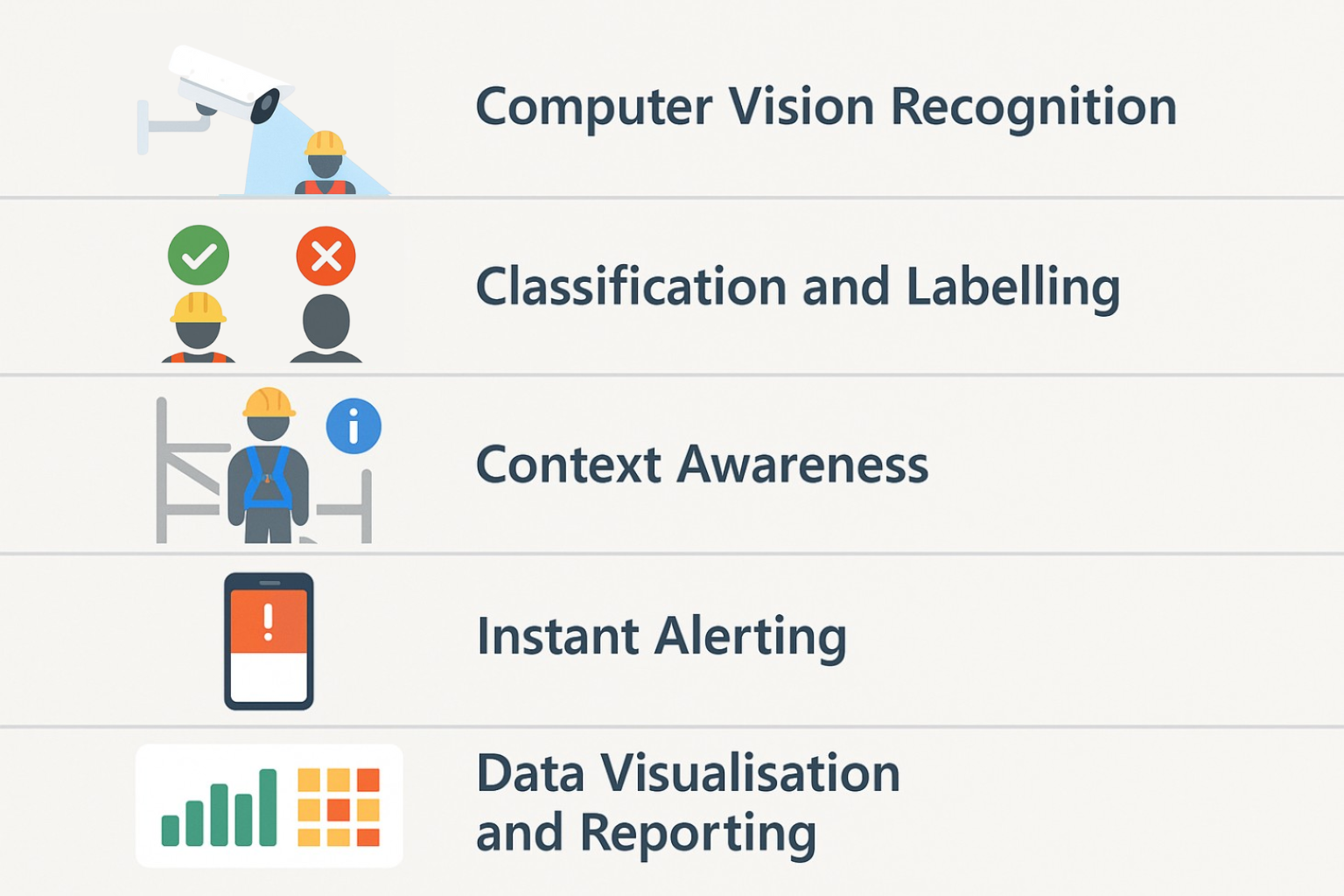
Automatic PPE detection relies on advances in computer vision, machine learning, and edge computing. These technologies work together to analyse live video feeds from standard CCTV or IP cameras.
1. Computer Vision Recognition
The system scans video frames and detects human figures within the camera’s field of view. Using trained deep-learning models, it identifies whether key PPE items are visible.
2. Classification and Labelling
The algorithm classifies detected workers as “compliant” or “non-compliant” based on visible items such as helmets, vests, or harnesses. This process takes place in real time, typically within milliseconds.
3. Context Awareness
More advanced models, such as those used in Invigilo’s SafeKey™, go beyond detection to analyse context. For example, they can check for the presence of a safety harness when a worker is on elevated scaffolding, or for a mask when the site environment indicates dust or fumes.
4. Instant Alerting
Once the system recognises a violation, it sends an alert to designated supervisors or safety officers through multiple channels. This prompt delivery prevents incidents rather than simply recording them.
5. Data Visualisation and Reporting
The gathered data feeds into a dashboard that presents heatmaps, frequency trends, and compliance rates by zone or shift. Over time, this data helps managers spot recurring patterns and plan targeted safety interventions.
Systems like SafeKey™ are calibrated for over 50 different safety risks, and their detection accuracy consistently exceeds 85 per cent in real-time operations. When sites undergo calibration and camera optimisation, accuracy rates of 90 to 95 per cent can be achieved even in busy construction environments.
If you are curious about how AI-based detection could enhance safety visibility at your site, contact Invigilo to learn how seamless CCTV integration can make automated compliance practical for your operations.
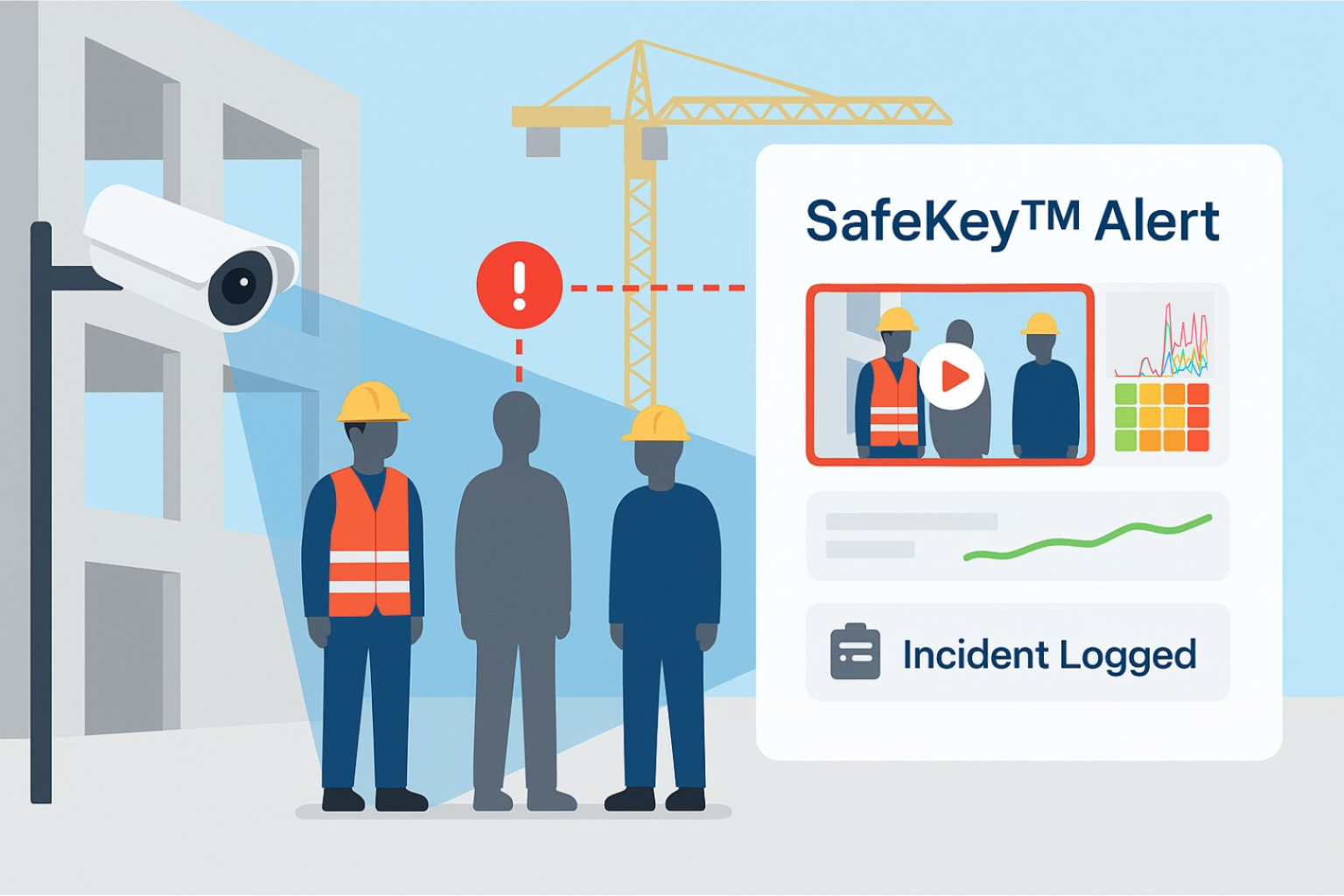
Invigilo’s SafeKey™ represents the next stage in practical, field-proven safety automation. Its architecture focuses on ease of adoption and high detection accuracy without requiring expensive equipment overhauls.
The platform connects directly to a site’s existing CCTV or IP camera infrastructure. This integration flexibility means companies can activate AI monitoring almost immediately without replacing hardware. For areas with insufficient coverage, Invigilo offers the option to install compatible cameras to fill blind spots.
Once connected, SafeKey™ continuously analyses video feeds to detect PPE-related risks. It identifies missing hard hats, reflective vests, masks, or suits, and can also detect the absence of harnesses during work-at-height activities. For projects with unique safety requirements, the platform can be customised to recognise additional PPE such as gloves or safety glasses.
When a potential non compliance is detected, SafeKey™ triggers instant alerts. These alerts are delivered to supervisors via WhatsApp, Microsoft Teams, or SMS. The dashboard then provides the following:
This integrated workflow converts routine observation into actionable safety intelligence. Supervisors gain immediate awareness of lapses and long-term visibility into safety patterns.
Equally important, Invigilo’s system has been designed with a privacy-first approach. As a Singapore-based provider, the company aligns its operations with Personal Data Protection Act (PDPA) guidelines. The platform allows each client to configure footage access, viewing permissions, and data retention periods to ensure compliance with company policy and regulatory requirements.
For further details on SafeKey™ integration, click here to see Invigilo’s offers.
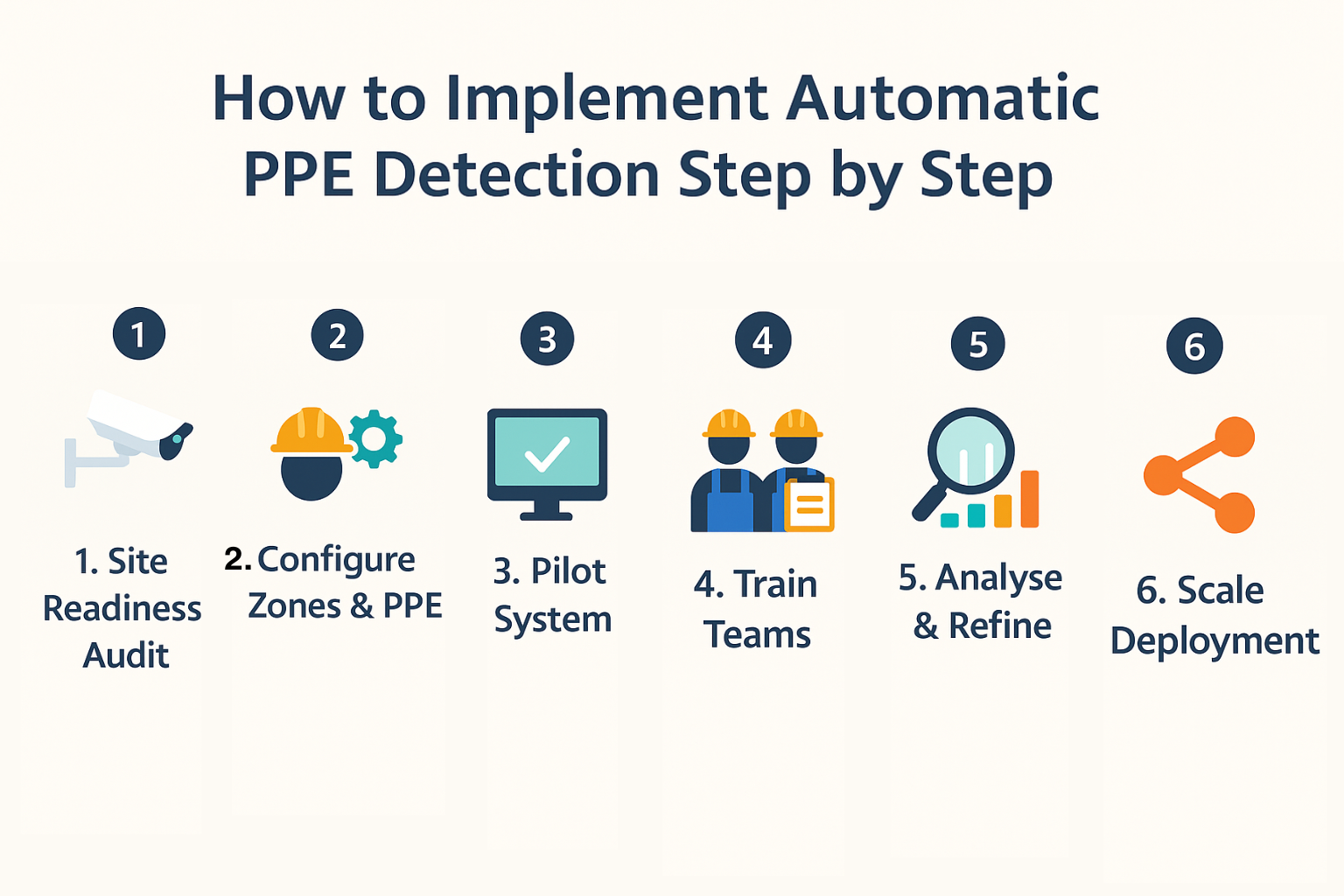
Deploying an AI-powered PPE detection system requires structured planning. Below is a practical step-by-step framework for construction firms considering automation.
Start by reviewing your camera infrastructure. Ensure that critical areas, such as entrances, scaffolds, loading zones, and tunnels, are within camera view and adequately lit. Low-quality footage or blind spots can significantly affect detection accuracy. Invigilo recommends calibrating existing cameras for angle, resolution, and coverage consistency before system activation.
Define which PPE items are mandatory for each area. For example, hard hats and vests may be required site-wide, while harnesses are only necessary for elevated work. Configuring detection rules by zone ensures the AI focuses on relevant items and reduces unnecessary alerts.
Begin with a controlled pilot in one or two sections of the site. Evaluate alert frequency, false positives, and supervisor response times. A pilot phase allows fine-tuning of the detection threshold and ensures the workflow integrates smoothly with existing safety processes.
Introduce the dashboard to safety officers and explain alert verification procedures. Conduct brief sessions for site workers so they understand that the system is designed to protect, not penalise. Reinforcing a positive safety culture prevents resistance and builds trust.
After several weeks of monitoring, review analytics reports. Identify recurring patterns, such as specific zones or time periods, where compliance drops. Use this data to plan targeted retraining or environmental improvements, such as better signage or PPE storage access.
Once the pilot demonstrates stability and acceptance, expand coverage to additional cameras and sites. Ensure continuous calibration as lighting, layout, or operational conditions evolve.
For deployment guidance, see Invigilo’s related article on implementing site-wide AI safety systems.
Even with powerful technology, successful implementation depends on human and operational factors. Below are common pitfalls and solutions.
1. Skipping calibration and testing
Failing to calibrate cameras for lighting and angles leads to frequent false alerts. Run calibration exercises during setup and whenever the environment changes.
2. Relying solely on AI
Automation supports supervision but does not replace it. Use AI for continuous detection, while supervisors handle context, verification, and coaching.
3.Lack of communication with workers
Workers may perceive AI monitoring as surveillance. Clear communication that explains the safety purpose reduces anxiety and ensures cooperation.
4. Neglecting data review
The value of AI lies in its analytics. Reviewing heatmaps and compliance trends regularly uncovers systemic risks that manual reports may miss.
5. Weak governance controls
Without clear rules on data access and retention, organisations risk privacy violations. Designate data custodians and formalise footage governance under PDPA guidelines.
Addressing these issues early ensures a smoother transition and a stronger return on investment.
Selecting an automated PPE detection solution is a strategic decision. It affects not just safety performance but also workflow integration, privacy management, and long-term scalability. Use the following evaluation framework when comparing vendors.
Ask for real-world accuracy statistics and examples from active projects. Avoid accepting laboratory results as representative of actual performance. Invigilo’s SafeKey™ achieves verified accuracy above 85 per cent in live environments and supports hard hats, reflective vests, suits, masks, and harnesses, with optional extensions for gloves and safety glasses.
Check if the platform integrates with your existing CCTV or IP camera systems. SafeKey™ connects directly to the current infrastructure, helping companies avoid costly equipment replacements. For incomplete coverage, Invigilo can install additional compatible cameras to ensure full site visibility.
Evaluate how quickly alerts are delivered and how reports are structured. A good system should deliver near-instant notifications and provide intuitive dashboards with visual analytics, heatmaps, and automated compliance reports. Invigilo’s platform uses WhatsApp, Teams, and SMS for immediate communication, which aligns with most site operations.
Data privacy is now a key decision factor. Confirm that the system allows configuration of user permissions and data retention. Ensure alignment with local regulations, especially Singapore’s PDPA. SafeKey™ was built with privacy as a design principle, providing configurable governance frameworks for footage management.
Determine whether the platform can support multiple projects under one account and whether local technical support is available. Invigilo’s scalable cloud infrastructure enables centralised monitoring for multiple construction sites, allowing large firms to consolidate analytics and benchmark safety performance.
Contact Invigilo on their SafeKey™ solution for detailed specifications.
Technology adoption in construction safety is accelerating. Several trends are expected to define the next phase of automated PPE detection and site safety systems.
CCTV-based detection will increasingly merge with IoT sensors and smart helmets to create multi-layered safety networks. These integrations will allow systems to detect not just PPE absence but also unsafe proximity to equipment or exposure to noise and heat.
Edge computing will play a central role in reducing latency and protecting privacy. By processing video on-site instead of sending it to the cloud, companies can maintain data control while achieving real-time response speeds.
Emerging AI architectures will be able to interpret both video and text, enabling automatic generation of safety summaries and incident briefs. This will streamline reporting and simplify compliance documentation.
Future models will include advanced detection of items such as gloves, footwear, and eyewear. Continuous dataset training will improve recognition accuracy for different lighting, materials, and cultural PPE variations.
As data accumulates, AI will transition from detection to prediction. Systems will forecast where and when non-compliance is likely to occur, allowing preventive measures before a single incident happens.
These trends are industry-wide and show the direction of safety innovation globally. Invigilo’s modular design positions its SafeKey™ platform to evolve alongside these developments, ensuring compatibility with emerging technologies.
Costs vary depending on site size, camera coverage, and monitoring scope. Most platforms operate on a subscription or per-camera pricing model. Although initial setup requires planning, savings from reduced downtime, fewer incidents, and lower insurance premiums often deliver rapid ROI.
Modern systems, including SafeKey™, support centralised dashboards that aggregate data from multiple locations. This scalability allows regional safety managers to compare compliance performance across sites and standardise training.
Supervisor training typically takes only a few sessions focused on dashboard interpretation and alert verification. Workers mainly require orientation to understand that the system enhances protection rather than surveillance.
Pilot programmes can be deployed within several weeks if the existing CCTV infrastructure is ready. Full-scale adoption may take one to two months, depending on site complexity and calibration needs.
When properly configured, accuracy rates range between 85 and 95 per cent for common PPE categories such as helmets and vests. Accuracy depends on environmental conditions, lighting, and camera resolution.
Vendors such as Invigilo implement strict governance frameworks. Clients can define user roles, control footage retention, and establish internal review policies to comply with privacy regulations like Singapore’s PDPA.
False alerts are mitigated through camera calibration, confidence threshold adjustment, and model retraining. Supervisors can review video clips directly before confirming an incident, ensuring data accuracy and user trust.
Construction projects continue to operate under tight timelines and complex site conditions, where even minor lapses can cause serious harm. Manual supervision alone cannot guarantee continuous compliance. Automated PPE detection bridges this gap by combining AI-driven vigilance with immediate human response.
Systems like Invigilo’s SafeKey™ demonstrate how automation enhances safety without adding operational complexity. They integrate with existing CCTV networks, detect key PPE categories such as helmets, vests, suits, masks, and harnesses, and deliver real-time alerts through familiar communication tools. With detection accuracy verified above 85 per cent and privacy governance aligned to Singapore’s PDPA, SafeKey™ has become a trusted foundation for proactive safety management.
For project owners, contractors, and safety leads, the business impact is significant. Reduced incident rates, stronger audit readiness, and measurable compliance improvements translate into tangible financial savings and higher trust among clients and regulators.
The technology is mature, proven, and scalable. The next step is practical adoption.
If your organisation is evaluating how to detect PPE non-compliance on a construction site automatically, start with a pilot using your current CCTV network. Review the results, refine your procedures, and scale confidently.
To learn more about real-world deployments and integration options, visit Invigilo’s SafeKey™ platform page or explore their AI-based safety blog. By adopting real-time detection today, construction leaders can build safer sites, protect their teams, and demonstrate accountability to every stakeholder.

Learn how to build a weekly safety dashboard from systems you already have, then layer AI video analytics on existing CCTV to quantify PPE and proximity risks by shift and zone. The article covers schema design, data contracts, quality checks, a practical pilot plan, and how to link improvements to reduced claims, downtime and penalties. Templates for ISO 45001 or OSHA exports and vendor validation steps are included.
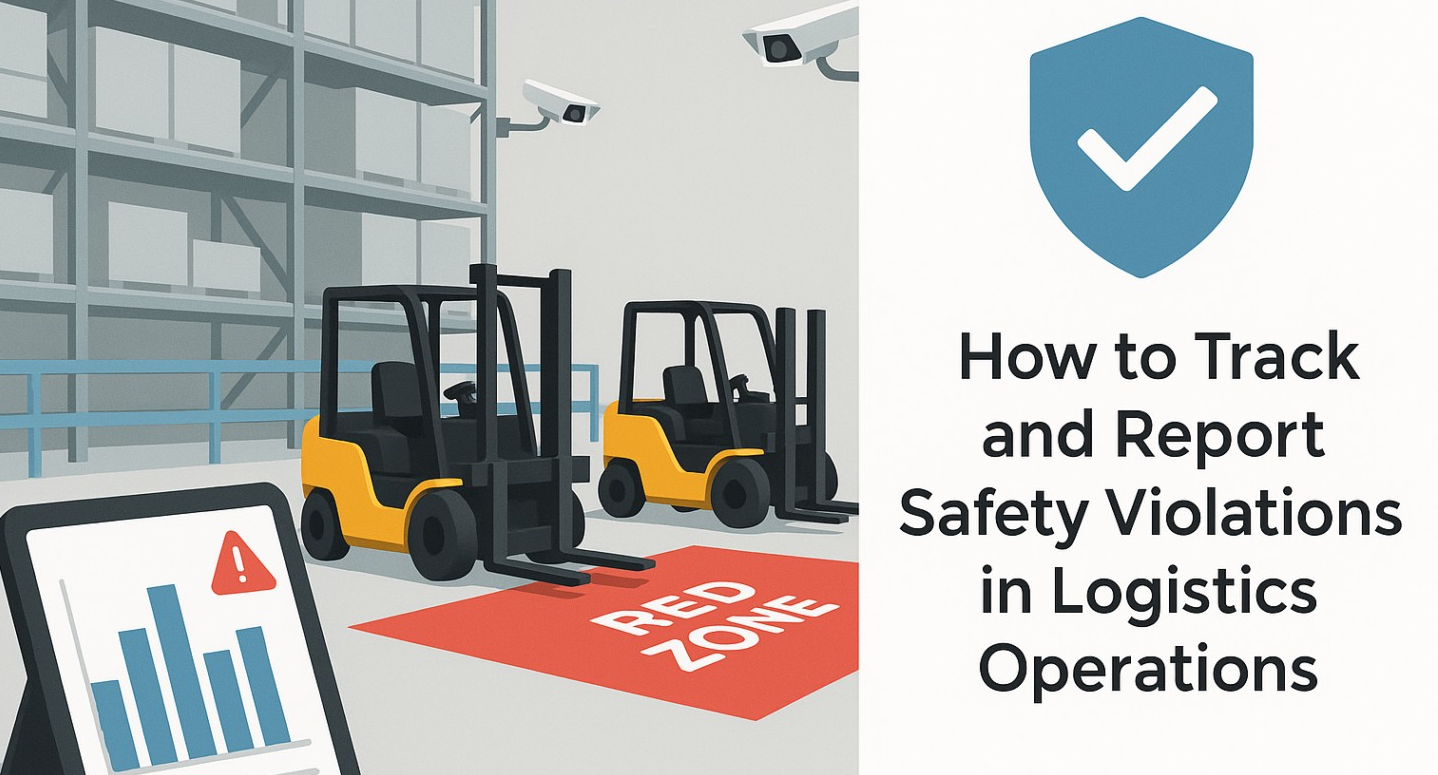
Read about how to track and report safety violations in logistics operations with AI-powered monitoring. This 2025 guide explains how Invigilo SafeKey™ helps warehouses detect unsafe acts in real time, automate reporting, and meet rising compliance standards.
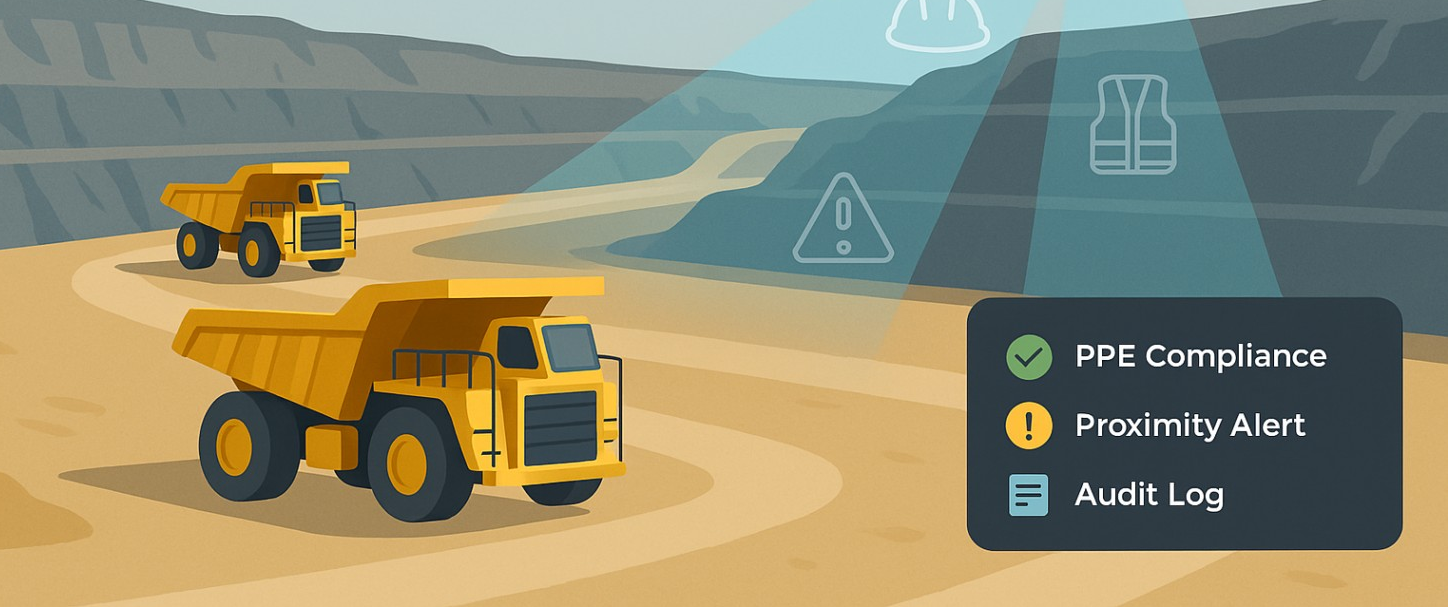
Learn practical ways to reduce incident risk in mines through automated AI-based monitoring. This 2025 guide explains how continuous AI-powered CCTV detection improves safety, ensures compliance, and integrates seamlessly with existing systems like Invigilo’s SafeKey™.
Ready to elevate safety in your operations? Let’s talk!
Contact us today for a personalized demo.
